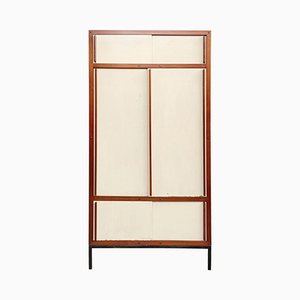
Born in Lyon, France in 1902, André Sorney was a French avant-garde furniture designer who, over a short and only recently rediscovered career, developed fabrication techniques of significant contribution to the era’s burgeoning minimalist, modernist aesthetic. A highly innovative talent who counted revered designers Le Corbusier, Charlotte Perriand, and Pierre Charpin among his contemporaries, Sorney remains, despite his impact, arguably the least internationally known of the French modernists—an obscurity most attributable to his career’s professional locus away from the cultural spotlight of Paris, in the then-bucolic Lyon.
Sornay began his professional career soon after his 1918 graduation from Lyon’s École Nationale Supérieure des Beaux-Arts (School of Fine Arts), pressed into the helm of his family’s furniture business upon his father’s passing in 1919. In an audacious move, Sornay ceased the firm’s sole focus on period reproductions, immediately shifting its range toward more modernist furniture— , , —characterized by clean lines, restrained decorative flourishes, and the nontraditional use of exotic woods like rosewood, mahogany, and sandblasted Oregon pine. This initial range spring-boarded Sornay, who in 1925, was selected to exhibit at the Exposition Internationale des Arts Décoratifs et Industriels Modernes in Paris.
Around the time of the financial crash in 1929, Sornay devised what would prove to be his signature technique: cloutage, a method of studding the exterior of veneered furniture panels with a series of perfectly proportioned nails. Patented in 1932, cloutage—which lowered manufacturing costs without sacrificing functionality or elegance—could be found on nearly every piece of Sornay’s 1930s oeuvre, from cabinets and multitiered tables to his distinctive angular-based Rosewood and Mahogany Armchairs (1935). Sornay continued to experiment with new manufacturing techniques in the following decades, culminating with his late 1940s pioneering of a new system to produce modular furniture, in which long metal or wood bolts were used to hold furniture panels together. This innovative design, like similar contemporaneous work such as Elias Svedberg’s Triva series for Nordiska Kompaniet, was essentially a precursor to Ikea’s flat-packed furniture.
Albeit at the height of his career, Sornay, in short time, ceded control of his design company to his children, moving into other professional realms sometime in the late 1950s. Onward into the millennium, his work waded in relative obscurity (outside the compass of a select few collectors), before enjoying a renaissance of sorts on the late 1990s vintage market by American clients who were tiring of elaborate late-18th- and early-19th-century furniture and Art Deco. Although still vastly more accessible than the work of Sourney’s peers—his pieces, which usually sell no more than $40,000 or $50,000, way below the millions the other French modernists often garner—Sorney’s oeuvre is steadily growing in revere, most notably thanks to recent monographs on his work like Signé Sornay by Marcelpoil and André Sornay: 1902-2000 by Lyon dealer Thierry Roche.
Sornay passed away in 2000.

